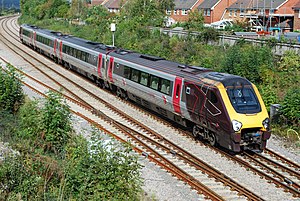British Rail Class 220
| British Rail Class 220 Voyager | |
|---|---|

CrossCountry 220002 passes Charfield on a Birmingham New St-Plymouth service.
|
|

The interior of Standard Class on board a Class 220.
|
|
| In service | 2001 — |
| Manufacturer | Bombardier Transportation |
| Built at | Bruges, Belgium |
| Family name | Voyager |
| Constructed | 2000–2001 |
| Number built | 34 trainsets |
| Number in service | 34 trainsets |
| Formation | 4 cars per trainset |
| Capacity | 174 standard class, 26 first class |
| Operator(s) | CrossCountry |
| Specifications | |
| Car body construction | Steel |
| Car length | 23.85 m (driving cars) or 22.82 m (intermediate cars) |
| Width | 2.73 m (8 ft 11 in) |
| Articulated sections | Flexible diaphragm (within unit only) |
| Maximum speed | 125 mph (200 km/h) |
| Weight | 185.6 t (182.7 long tons; 204.6 short tons) per trainset |
| Traction system | DEMU |
| Prime mover(s) | Cummins QSK19 |
| Power output | Each engine: 560 kW (750 hp) at 1800 rpm Total: 3,000 hp (2,240 kW) |
| Transmission | Diesel-electric |
| UIC classification | 1A'A1'+1A'A1'+1A'A1'+1A'A1' |
| Braking system(s) | Rheostatic |
| Safety system(s) | AWS, TPWS |
| Coupling system | Dellner |
| Track gauge | 1,435 mm (4 ft 8 1⁄2 in) |
The Class 220 Voyager is a class of diesel-electric high-speed multiple-unit trains built in Belgium by Bombardier Transportation in 2000 and 2001.
They were introduced in 2001 to replace the 30-year-old InterCity 125 and Class 47 fleets operating on the Cross Country Route, initially for Virgin Trains and since 2007 by CrossCountry.
All coaches are equipped with a Cummins QSK19 diesel engine of 750 hp (560 kW) at 1800rpm. These power a generator which supplies current to motors driving two axles per coach, with one axle per bogie powered.
Voyagers have both air and rheostatic brakes. They are fitted with Dellner couplers, like the Class 222, operated by East Midlands Trains and the Class 390 Pendolino electric trains used by Virgin West Coast meaning they can be coupled in rescue/recovery mode (air brake only) in the event of a failure. 220s and 221s can also be easily assisted by Dellner fitted Class 57s (Thunderbirds) in the event of a failure. By use of adaptive couplings a failed 220 or 221 can also be assisted by any air braked locomotive such as a Class 37, 47 or 66 or even an HST. The units can work in multiple with Class 221 units but not Class 222 units as the electrical connections of the Class 222 units are incompatible with the Class 220.
...
Wikipedia
